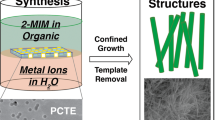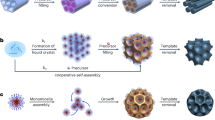Abstract
Metal–organic frameworks (MOFs) are among the most attractive porous materials known today. Their miniaturization to the nanoscale—into nanoMOFs—is expected to serve myriad applications from drug delivery to membranes, to open up novel avenues to more traditional storage and catalysis applications, and to enable the creation of sophisticated superstructures. Here, we report the use of spray-drying as a versatile methodology to assemble nanoMOFs, yielding spherical hollow superstructures with diameters smaller than 5 µm. This strategy conceptually mimics the emulsions used by chemists to confine the synthesis of materials, but does not require secondary immiscible solvents or surfactants. We demonstrate that the resulting spherical, hollow superstructures can be processed into stable colloids, whose disassembly by sonication affords discrete, homogeneous nanoMOFs. This spray-drying strategy enables the construction of multicomponent MOF superstructures, and the encapsulation of guest species within these superstructures. We anticipate that this will provide new routes to capsules, reactors and composite materials.
This is a preview of subscription content, access via your institution
Access options
Subscribe to this journal
Receive 12 print issues and online access
$259.00 per year
only $21.58 per issue
Buy this article
- Purchase on Springer Link
- Instant access to full article PDF
Prices may be subject to local taxes which are calculated during checkout





Similar content being viewed by others
References
Carné, A., Carbonell, C., Imaz, I. & Maspoch, D. Nanoscale metal–organic materials. Chem. Soc. Rev. 40, 291–305 (2011).
Spokoyny, A. M., Kim, D., Sumrein, A. & Mirkin, C. A. Infinite coordination polymer nano- and microparticle structures. Chem. Soc. Rev. 38, 1218–1227 (2009).
Lin, W., Rieter, W. J. & Taylor, K. M. L. Modular synthesis of functional nanoscale coordination polymers. Angew. Chem. Int. Ed. 48, 650–658 (2009).
Horcajada, P. et al. Metal–organic frameworks in biomedicine. Chem. Rev. 112, 1232–1268 (2012).
Horcajada, P. et al. Porous metal–organic-framework nanoscale carriers as a potential platform for drug delivery and imaging. Nature Mater. 9, 172–178 (2010).
Rieter, W. J. et. al. Nanoscale metal–organic frameworks as potential multimodal contrast enhancing agents. J. Am. Chem. Soc. 128, 9024–9025 (2006).
Kreno, L. E. Metal–organic framework materials as chemical sensors. Chem. Rev. 112, 1105–1125 (2012).
Bétard, A. & Fischer, R. A. Metal–organic framework thin films: from fundamentals to applications. Chem. Rev. 112, 1055–1083 (2012).
Scherb, C., Schödel, A. & Bein, T. Directing the structure of metal–organic frameworks by oriented surface growth on an organic monolayer. Angew. Chem. Int. Ed. 47, 5777–5779 (2008).
Shimomura, S. et al. Selective sorption of oxygen and nitric oxide by an electron-donating flexible porous coordination polymer. Nature Chem. 2, 633–637 (2010).
Bux, H. et al. Oriented zeolitic imidazolate framework-8 membrane with sharp H2/C3H8 molecular sieve separation. Chem. Mater. 23, 2262–2269 (2011).
Park, K. H., Jang, K., Son, S. U. & Sweigart, D. A. Self-supported organometallic rhodium quinonoid nanocatalysts for stereoselective polymerization of phenylacetylene. J. Am. Chem. Soc. 128, 8740–8741 (2006).
Lu, G. et al. Imparting functionality to a metal–organic framework material by controlled nanoparticle encapsulation. Nature Chem. 4, 310–316 (2012).
Ni, Z. & Masel, R. I. Rapid production of metal–organic frameworks via microwave-assisted solvothermal synthesis. J. Am. Chem. Soc. 128, 12394–12395 (2006).
Vaucher, S. & Mann, S. Synthesis of Prussian blue nanoparticles and nanocrystal superlattices in reverse microemulsions. Angew. Chem. Int. Ed. 39, 1793–1796 (2000).
Lee, H. J., Cho, W. & Oh, M. Advanced fabrication of metal–organic frameworks: template-directed formation of polystyrene@ZIF-8 core–shell and hollow ZIF-8 microspheres. Chem. Commun. 48, 221–223 (2012).
Hu, M. et al. Synthesis of Prussian blue nanoparticles with a hollow interior by controlled chemical etching. Angew. Chem. Int. Ed. 51, 984–988 (2012).
Ameloot, R. et al. Interfacial synthesis of hollow metal–organic framework capsules demonstrating selective permeability. Nature Chem. 3, 382–387 (2011).
Yu, L. Amorphous pharmaceutical solids: preparation, characterization and stabilization. Adv. Drug Deliv. Rev. 48, 27–42 (2001).
Reinhard, V. Pharmaceutical particle engineering via spray drying. Pharm. Res. 25, 999–1022 (2008).
Boissiere, C. et al. Aerosol route to functional nanostructured inorganic and hybrid porous materials. Adv. Mater. 23, 599–623 (2011).
Cheow, W. S., Li, S. & Hadinoto, K. Spray drying formulation of hollow spherical aggregates of silica nanoparticles by experimental design. Chem. Eng. Res. Des. 88, 673–685 (2010).
Xu, H., Tan, Z., Abe, Z. & Naito, M. Microcapsule assembly of single-walled carbon nanotubes from spray-dried hollow microspheres. J. Ceram. Soc. Jpn 119, 180–184 (2011).
Luo, P. & Nieh, T. G. Synthesis of ultrafine hydroxyapatite particles by a spray dry method. Mater. Sci. Eng. C 3, 75–78 (1995).
Maas, S. G. The impact of spray drying outlet temperature on the particle morphology of mannitol. Powder Tech. 213, 27–35 (2011).
Chui, S. S-Y. et al. Chemically functionalizable nanoporous material [Cu3(TMA)2(H2O)3]n . Science 283, 1148–1150 (1999).
Carson, C. G. et al. Synthesis and structure characterization of copper terephthalate metal–organic frameworks. Eur. J. Inorg. Chem. 2338–2343 (2009).
Chen, B. et al. High H2 adsorption in a microporous metal–organic framework with open metal sites. Angew. Chem. Int. Ed. 44, 4745–4749 (2005).
Surblé, S. et al. A new isoreticular class of metal–organic frameworks with the MIL-88 topology. Chem. Commun. 284–286 (2006).
Chen, B. et al. Interwoven metal–organic framework on a periodic minimal surface with extra-large pores. Science 291, 1021–1023 (2001).
Rosi, N. L. et al. Rod packings and metal–organic frameworks constructed from rod-shaped secondary building units. J. Am. Chem. Soc. 127, 1504–1518 (2005).
Cavka, J. H. et al. A new zirconium inorganic building brick forming metal organic frameworks with exceptional stability. J. Am. Chem. Soc. 130, 13850–13851 (2008).
Park, K. S. et al. Exceptional chemical and thermal stability of zeolitic imidazolate frameworks. Proc. Natl Acad. Sci. USA 103, 10186–10191 (2006).
Kaye, S. S. & Long, J. R. Hydrogen storage in the dehydrated Prussian blue analogues M3[Co(CN)6]2 (M=Mn, Fe, Co, Ni, Cu, Zn). J. Am. Chem. Soc. 127, 6506–6507 (2006).
Li, H., Eddaoudi, M., O'Keeffe, M. & Yaghi, O. M. Design and synthesis of an exceptionally stable and highly porous metal–organic framework. Nature 402, 276–279 (1999).
Eddaoudi, M. et al. Systematic design of pore size and functionality in isoreticular MOFs and their application in methane storage. Science 295, 469–472 (2002).
Lin, X., Jia, J., Hubberstey, P., Schröder M. & Champness, N. R. Hydrogen storage in metal–organic frameworks. CrystEngComm 9, 438–448 (2007).
Li, X. A. et al. Nanospray drier nanoparticles by spray drying using innovative new technology: the Buchi Nano Spray Drier B-90. J. Control. Rel. 147, 304–310 (2010).
Chalati, T., Horcajada, P., Gref, R., Couvreur, P. & Serre, C. Optimisation of the synthesis of MOF nanoparticles made of flexible porous iron fumarate MIL-88a J. Mater. Chem. 21, 2220–2227 (2011).
Cychosz, K. A., Wong-Foy, A. G. & Matzger, A. J. Liquid phase adsorption by microporous coordination polymers: removal of organosulfur compounds. J. Am. Chem. Soc. 130, 6938–6939 (2008).
Cychosz, K. A., Wong-Foy, A. G. & Matzger, A. Enabling cleaner fuels: desulfurization by adsorption to microporous coordination polymers. J. Am. Chem. Soc. 131, 14538–14543 (2009).
Acknowledgements
The authors acknowledge the Servei de Microscopia of the UAB, and Carlos Carbonell for helping with the illustrations. I.I. and M.C.S. thank MICINN and ICN for a Ramón y Cajal grant and a research contract, respectively. A.C. thanks the Generalitat de Catalunya for a FI fellowship.
Author information
Authors and Affiliations
Contributions
A.C., I.I. and M.C.S. designed the experiments, performed the syntheses and carried out the characterization, encapsulation and property studies. D.M. conceived the project and drafted the manuscript. All authors discussed the results and commented on the manuscript.
Corresponding author
Ethics declarations
Competing interests
The authors have a patent pending on the methods described in this manuscript, filed on 4 October 2011 (European Union application number EP 11183773.8).
Supplementary information
Supplementary information
Supplementary information (PDF 7226 kb)
Rights and permissions
About this article
Cite this article
Carné-Sánchez, A., Imaz, I., Cano-Sarabia, M. et al. A spray-drying strategy for synthesis of nanoscale metal–organic frameworks and their assembly into hollow superstructures. Nature Chem 5, 203–211 (2013). https://doi.org/10.1038/nchem.1569
Received:
Accepted:
Published:
Issue Date:
DOI: https://doi.org/10.1038/nchem.1569
This article is cited by
-
Heterogeneous intercalated metal-organic framework active materials for fast-charging non-aqueous Li-ion capacitors
Nature Communications (2023)
-
Sub-second ultrafast yet programmable wet-chemical synthesis
Nature Communications (2023)
-
Metal-organic frameworks: Synthetic methods for industrial production
Nano Research (2023)
-
Engineering 2D Cu-composed metal–organic framework nanosheets for augmented nanocatalytic tumor therapy
Journal of Nanobiotechnology (2022)
-
Metal–Organic Framework Materials for Electrochemical Supercapacitors
Nano-Micro Letters (2022)



